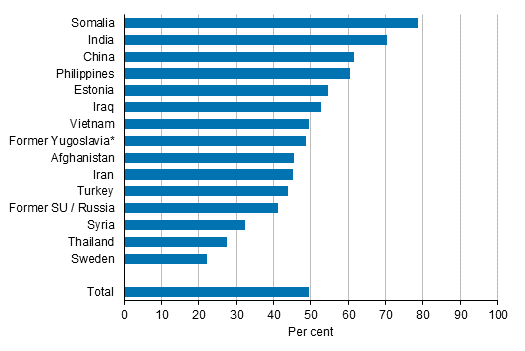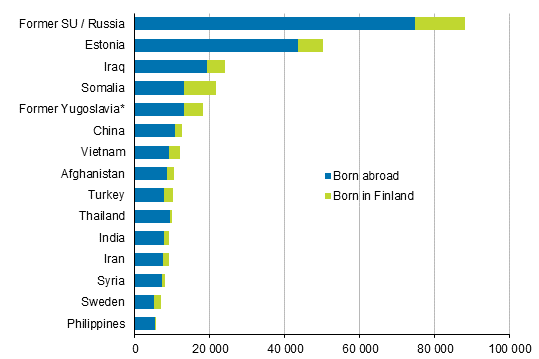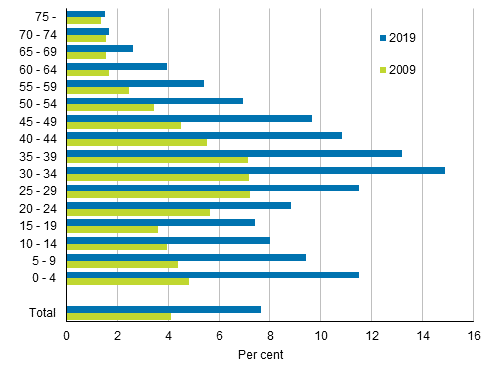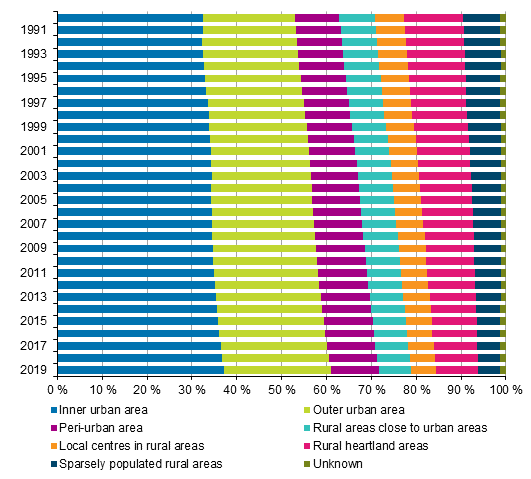Published: 29 May 2020
As many as one-half of Finland's population with foreign background are living in Greater Helsinki
According to Statistics Finland, there were 423,494 persons with foreign background living in Finland at the end of 2019. Of them, 209,108 or one-half lived in Greater Helsinki. Among the largest groups with foreign background, those with Somali background, 79 per cent, and those with Indian background, 70 per cent, have concentrated in Greater Helsinki.
Share of persons living in Greater Helsinki by background country in 2019

*) includes Bosnia and Herzegovina, Croatia, Rep. of Macedonia, Montenegro, Serbia, Slovenia
One in four under school-age children of foreign background in Greater Helsinki
The share of under school-age children (aged 0 to 6) with foreign background living in Finland was 11 per cent at the end of 2019. One in four under school-age children are already of foreign background in Greater Helsinki.
Examined by municipality, the share of persons with foreign background among under school-age children was highest in Mainland Finland in Närpiö, 31 per cent, and in Vantaa, 30 per cent.
Examined by region, one in five under school-age children were of foreign background in Åland and Uusimaa. The share of persons with foreign background among under school-age children was lowest in Central and South Ostrobothnia, around three per cent.
Syria and the Philippines have risen among the 15 largest background countries
At the end of 2019, clearly the largest group of people with foreign background is still those whose background country is the former Soviet Union or Russia. The second largest group is equally clearly those of Estonian origin. People with Iraqi background came third.
Over the past ten years, those with German and British background have dropped from the 15 largest groups with foreign background. People of Syrian and Philippine background have taken their place.
Largest groups with foreign background in Finland’s population at the end of 2019

*) includes Bosnia and Herzegovina, Croatia, Rep. of Macedonia, Montenegro, Serbia, Slovenia
Average age of persons with foreign background 33.8 years
The average age of the population with foreign background living in Finland was 33.8 years at the end of 2019. The average age of persons with foreign background in the first generation, that is, those born abroad, was 38.4 years and that of persons with foreign background in the second generation born in Finland was 11.1 years. At the end of 2019, there were 71,773 persons with foreign background in the second generation, that is, every sixth person with foreign background was born in Finland.
The average age of the population with Finnish background stood at 43.9 years at the end of 2019.
Share of population with foreign background by age at the end of 2009 and 2019

Around one in three Finns living in inner urban areas
At the end of 2019, a total of 37 per cent of Finland's population were living in inner urban areas. The inner urban area describes the dense and uniform efficiently built area of cities. Every fourth Finn lived in the outer urban area. The outer urban area consists of separate suburbs, the edge city of commerce, industry and offices, as well as the green areas of the town and the residential areas of lower efficiency. The outer boundary of the outer urban area estimates the external border of the planned area.
Every tenth Finn lived in the peri-urban area. The peri-urban area covers mixed areas in the immediate vicinity of the town. It includes both dense urban areas and rural areas.
Seven per cent of Finns lived in rural areas close to urban areas. Rural areas close to urban areas are areas with a rural character that are functionally and physically connected to urban areas.
Every tenth Finn lived in rural heartland areas and five per cent in sparsely populated rural areas. The rural heartland area is either a strong primary production area or relatively densely populated rural areas with diverse activities. The rural heartland area is relatively far away from large centres. Sparsely populated rural areas are areas that have a one-sided local economic structure and are sparsely populated areas situated far from large centres.
Further information about the updated urban-rural classification
is available at: https://www.ymparisto.fi/kaupunkimaaseutuluokitus
and
https://www.ymparisto.fi/en-US/Living_environment_and_planning/Community_structure/Information_about_the_community_structure/Urbanrural_classification
Population by urban-rural classification in 1990 to 2019

Source: Population Structure 2019, Statistics Finland
Inquiries: Markus Rapo 029 551 3238, info@stat.fi, vaesto.tilasto@stat.fi
Director in charge: Jari Tarkoma
Publication in pdf-format (313.1 kB)
- Tables
-
Tables in databases
Pick the data you need into tables, view the data as graphs, or download the data for your use.
- Figures
- Quality descriptions
-
- Quality description: Population structure 2019 (29.5.2020)
Updated 29.05.2020
Official Statistics of Finland (OSF):
Population structure [e-publication].
ISSN=1797-5395. annual review 2019. Helsinki: Statistics Finland [referred: 25.12.2025].
Access method: http://stat.fi/til/vaerak/2019/02/vaerak_2019_02_2020-05-29_tie_001_en.html

